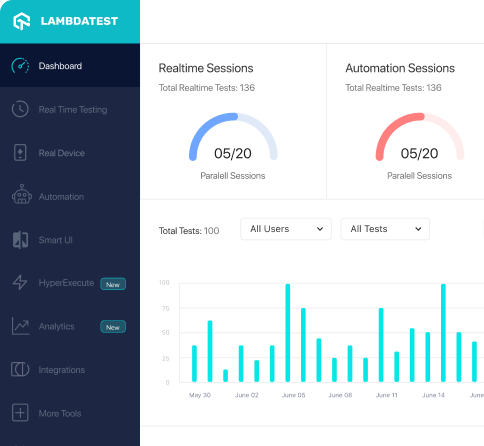How to use LocalDateTimeAssert_usingDefaultComparator_Test class of org.assertj.core.api.localdatetime package
Best Assertj code snippet using org.assertj.core.api.localdatetime.LocalDateTimeAssert_usingDefaultComparator_Test
...15import java.time.LocalDateTime;16import org.assertj.core.api.AbstractLocalDateTimeAssertBaseTest;17import org.assertj.core.api.LocalDateTimeAssert;18import org.assertj.core.internal.ChronoLocalDateTimeComparator;19class LocalDateTimeAssert_usingDefaultComparator_Test extends AbstractLocalDateTimeAssertBaseTest {20 @Override21 protected LocalDateTimeAssert invoke_api_method() {22 return assertions.usingComparator(LocalDateTime::compareTo)23 .usingDefaultComparator();24 }25 @Override26 protected void verify_internal_effects() {27 assertThat(getComparables(assertions).getComparator()).isEqualTo(ChronoLocalDateTimeComparator.getInstance());28 assertThat(getObjects(assertions).getComparator()).isNull();29 }30}...LocalDateTimeAssert_usingDefaultComparator_Test
Using AI Code Generation
1assertThat(localDateTime).isEqualToIgnoringNanos(expected);2assertThat(localDateTime).isEqualToIgnoringSeconds(expected);3assertThat(localDateTime).isEqualToIgnoringMinutes(expected);4assertThat(localDateTime).isEqualToIgnoringHours(expected);5assertThat(localDateTime).isEqualToIgnoringDays(expected);6assertThat(localDateTime).isEqualToIgnoringMonths(expected);7assertThat(localDateTime).isEqualToIgnoringYears(expected);8assertThat(localDateTime).isEqualToIgnoringTime(expected);9assertThat(localDateTime).isEqualToIgnoringTimezone(expected);10assertThat(localDateTime).isAfterOrEqualTo(expected);11assertThat(localDateTime).isAfter(expected);12assertThat(localDateTime).isBeforeOrEqualTo(expected);13assertThat(localDateTime).isBefore(expected);14assertThat(localDateTime).isBetween(start, end);15assertThat(localDateTime).isBetweenOrEqualTo(start, end);16assertThat(localDateTime).isCloseTo(expected, offset);17assertThat(localDateTime).isCloseTo(expected, offset, strict);18assertThat(localDateTime).isCloseTo(expected, offset, strict, strictOffset);19assertThat(localDateTime).isCloseTo(expected, offset, strict, strictOffset, strictTimezone);20assertThat(localDateTime).isCloseTo(expected, offset, strict, strictOffset, strictTimezone, strictYear);21assertThat(localDateTime).isCloseTo(expected, offset, strict, strictOffset, strictTimezone, strictYear, strictMonth);22assertThat(localDateTime).isCloseTo(expected, offset, strict, strictOffset, strictTimezone, strictYear, strictMonth, strictDay);23assertThat(localDateTime).isCloseTo(expected, offset, strict, strictOffset, strictTimezone, strictYear, strictMonth, strictDay, strictHour);24assertThat(localDateTime).isCloseTo(expected, offset, strict, strictOffset, strictTimezone, strictYear, strictMonth, strictDay, strictHour, strictMinute);25assertThat(localDateTime).isCloseTo(expected, offset, strict, strictOffset, strictTimezone, strictYear, strictMonth, strictDay, strictHour, strictMinute, strictSecond);26assertThat(localDateTime).isCloseTo(expected, offset, strict, strictOffset, strictTimezone, strictYear, strictMonth, strictDay, strictHour, strictMinute, strictSecond, strictNanos);27assertThat(localDateTime).isCloseTo(expected, offset, strict, strictOffset, strictTimezone, strictYear, strictMonth, strictDay, strictHour, strictMinute, strictSecond, strictNanos, strictTimezoneLocalDateTimeAssert_usingDefaultComparator_Test
Using AI Code Generation
1import org.assertj.core.api.LocalDateTimeAssert;2import org.assertj.core.api.LocalDateTimeAssert_usingDefaultComparator_Test;3import java.time.LocalDateTime;4public class LocalDateTimeAssert_usingDefaultComparator_short_Test extends LocalDateTimeAssert_usingDefaultComparator_Test {5 protected LocalDateTimeAssert invoke_api_method() {6 return assertions.usingDefaultComparator();7 }8 protected void verify_internal_effects() {9 assertThat(getObjects(assertions)).usingDefaultComparator().containsExactly(actual);10 }11}12public LocalDateTimeAssert_usingDefaultComparator_Test usingDefaultComparator() {13 objects = newLinkedHashSet(actual);14 return myself;15}16private static LinkedHashSet<LocalDateTime> getObjects(LocalDateTimeAssert originalAssertion) {17 return getField("objects", originalAssertion);18}19public static <T> T getField(String fieldName, Object target) {20 try {21 Field field = target.getClass().getDeclaredField(fieldName);22 field.setAccessible(true);23 return (T) field.get(target);24 } catch (Exception e) {25 throw new IntrospectionError("Unable to get value of field <" + fieldName + "> on object <" + target + ">", e);26 }27}28public class IntrospectionError extends AssertionError {29 private static final long serialVersionUID = 1L;30 public IntrospectionError(String message, Throwable cause) {31 super(message, cause);32 }33}34public static <T> T getField(String fieldName, Object target) {35 try {36 Field field = target.getClass().getDeclaredField(fieldName);37 field.setAccessible(true);38 return (T) field.get(target);39 } catch (Exception e) {40 throw new IntrospectionError("Unable to get value of field <" + fieldName + "> on object <" + target + ">", e);41 }42}43public static <T> T getField(String fieldName, Object target) {Blogs
Check out the latest blogs from LambdaTest on this topic:
Companies are using DevOps to quickly respond to changing market dynamics and customer requirements.
Smartphones have changed the way humans interact with technology. Be it travel, fitness, lifestyle, video games, or even services, it’s all just a few touches away (quite literally so). We only need to look at the growing throngs of smartphone or tablet users vs. desktop users to grasp this reality.
“Test frequently and early.” If you’ve been following my testing agenda, you’re probably sick of hearing me repeat that. However, it is making sense that if your tests detect an issue soon after it occurs, it will be easier to resolve. This is one of the guiding concepts that makes continuous integration such an effective method. I’ve encountered several teams who have a lot of automated tests but don’t use them as part of a continuous integration approach. There are frequently various reasons why the team believes these tests cannot be used with continuous integration. Perhaps the tests take too long to run, or they are not dependable enough to provide correct results on their own, necessitating human interpretation.
Xamarin is an open-source framework that offers cross-platform application development using the C# programming language. It helps to simplify your overall development and management of cross-platform software applications.
Enterprise resource planning (ERP) is a form of business process management software—typically a suite of integrated applications—that assists a company in managing its operations, interpreting data, and automating various back-office processes. The introduction of a new ERP system is analogous to the introduction of a new product into the market. If the product is not handled appropriately, it will fail, resulting in significant losses for the business. Most significantly, the employees’ time, effort, and morale would suffer as a result of the procedure.
Automation Testing Tutorials
Learn to execute automation testing from scratch with LambdaTest Learning Hub. Right from setting up the prerequisites to run your first automation test, to following best practices and diving deeper into advanced test scenarios. LambdaTest Learning Hubs compile a list of step-by-step guides to help you be proficient with different test automation frameworks i.e. Selenium, Cypress, TestNG etc.
LambdaTest Learning Hubs:
- JUnit Tutorial
- TestNG Tutorial
- Webdriver Tutorial
- WebDriverIO Tutorial
- Protractor Tutorial
- Selenium 4 Tutorial
- Jenkins Tutorial
- NUnit Tutorial
- Jest Tutorial
- Playwright Tutorial
- Cypress Tutorial
- PyTest Tutorial
YouTube
You could also refer to video tutorials over LambdaTest YouTube channel to get step by step demonstration from industry experts.
Most used methods in LocalDateTimeAssert_usingDefaultComparator_Test
Try LambdaTest Now !!
Get 100 minutes of automation test minutes FREE!!



